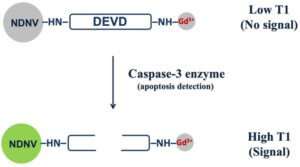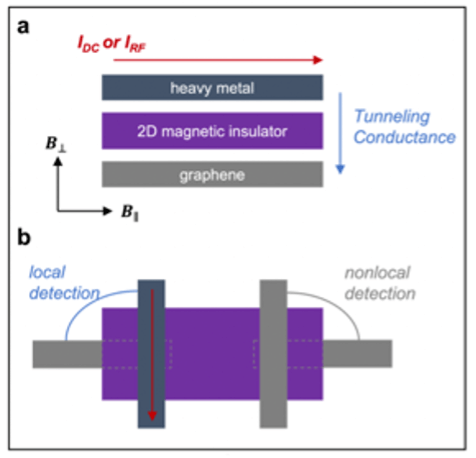Summary
Chemotherapy is limited by the failure to clinically monitor the efficacy of the treatment in real-time, which results in suboptimal chemotherapy being given for a prolonged period. Predicting the outcome of chemotherapy immediately after drug administration can increase diagnostic accuracy, efficacy outcomes, and successful treatment. Quantum nanodiamond sensors can be used as optical sensors and drug delivery probes for chemotherapy. In particular, nanodiamonds containing nitrogen-vacancy (NV) centers can serve as attractive probes for optically sensing chemical reactions and biological processes, thanks to their small size, bio-compatibility, and fluorescent properties of the NV centers. This work focuses on variations in the relaxation time in the nanodiamond NV centers, which change when the nanodiamonds are brought into proximity to Gadolinium (Gd) ions – for example, by using a peptide sequence as a connector between the nanodiamond and a Gd compound – and can be optically monitored. The experiment will investigate one type of action of chemotherapeutic drugs, which is to induce cell death (apoptosis) of the cancer cells. Specific enzymes released during apoptosis can cut the connection between the nanodiamonds and Gd, separating NVs from the Gd and decreasing the relaxation rate. Thus, observing the differences in relaxation rate upon chemotherapy allows the drug’s efficacy to be immediately monitored.

Figure 1. A specific enzyme (Caspase 3) is released in the presence of an effective chemotherapeutic drug, resulting in the separation of nanodiamonds and Gd and decreasing the relaxation rate.
Related Content

Quantum Dynamics of Cavity Interactions with Spin Ensembles
Summary High quality factor cavities can be powerful control elements for ensembles of spins, enabling unitary control as well as on demand cooling. They can also be used to couple two otherwise non-interacting ensembles. The goal of the project is to explore the physics and engineering of such systems both theoretically and experimentally. The laboratory contains a […]
September 7, 2016

Topological Quantum Computing on Majorana Platform
Full-scale quantum computing will require the capability for error-tolerant quantum information processing.
January 11, 2017

Coherent magnon generation, magnon condensation, and quantum spin liquids via spin pumping in 2D magnets
Summary Developing hybrid quantum systems is essential to harnessing the complementary advantages of different quantum technology platforms. This necessitates the successful transfer of quantum information between platforms, which can be achieved, e.g., by harnessing magnons, or spin wave excitations, in magnetic materials. Decoherence due to uncontrolled coupling of qubits to the environment remains a fundamental […]
February 1, 2023

Portable Quantum Dot Measurement System
Summary Detecting heavy metals in water is essential to ensure clean drinking water and appropriate regulatory decisions following an accident (e.g., a spill) or an emergency. Traditionally, high-sensitivity detection of heavy metals requires bulky and costly (to purchase and operate) lab-based instruments. We propose developing a palm-sized, element-specific, highly-sensitive, battery-operated, smartphone-controlled system for on-site measurement […]
July 21, 2022

